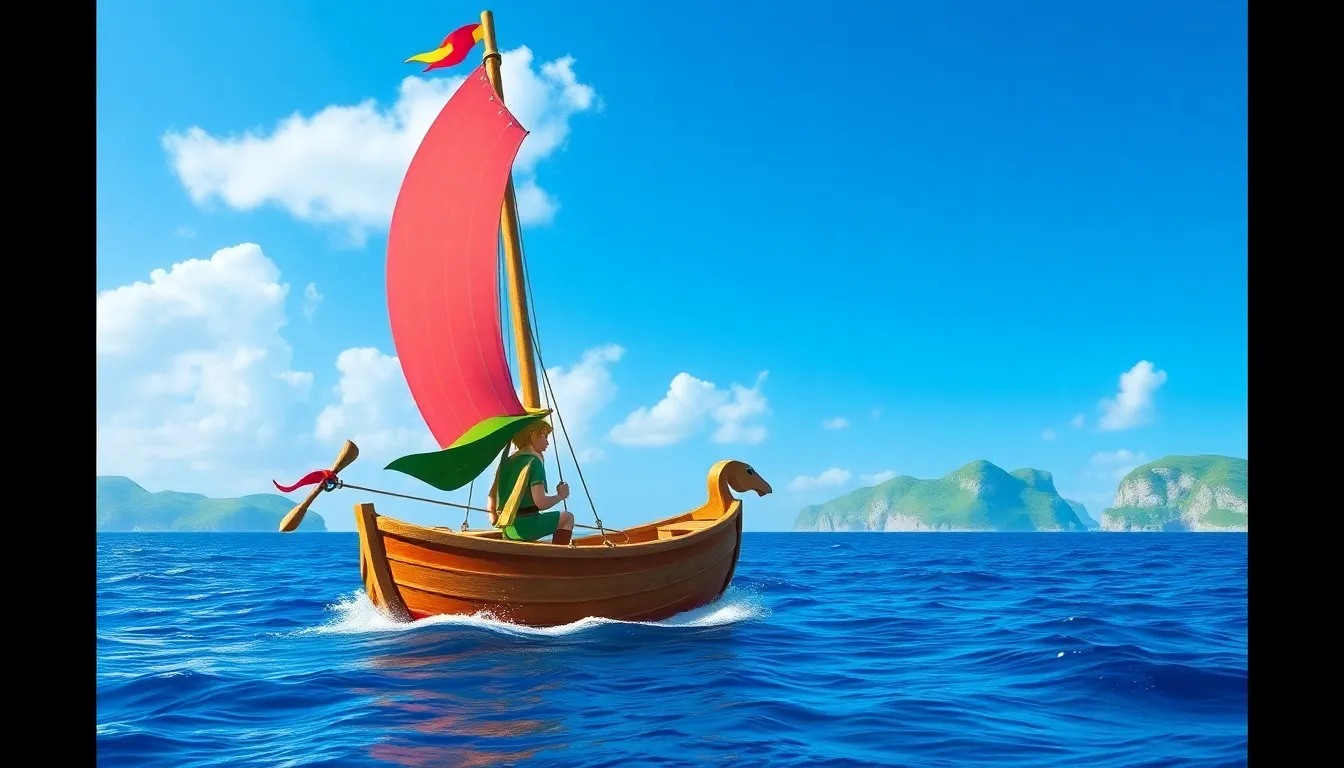In the vast ocean of gaming, few titles have made waves quite like The Legend of Zelda: The Wind Waker. With its vibrant cel-shaded graphics and whimsical charm, this game invites players to set sail on an unforgettable adventure. Who wouldn’t want to explore a world where pirates, talking boats, and treasure maps collide in a delightful mashup of fantasy and fun?
Table of Contents
ToggleOverview of Zelda Wind Waker
“The Legend of Zelda: The Wind Waker” captivates players with its distinctive art style and engaging gameplay. Released in 2002 for the Nintendo GameCube, the game features cell-shaded graphics, creating a unique visual appeal. A vast ocean world awaits exploration, filled with islands, treasure, and adventure. Players navigate this expansive sea on a talking boat named the King of Red Lions, who aids Link on his quest.
Link, the protagonist, embarks on a mission to rescue his sister, Aryll, from the clutches of the evil pirate Ganondorf. Along the journey, players encounter various islands, each harboring secrets and puzzles. Many characters enrich the narrative, including the charming Tetra, a pirate with her own mysterious past.
The combat system accommodates various enemies, requiring strategy and skill. Items like the boomerang and grappling hook become essential tools for solving puzzles and defeating foes. Players experience challenges that evoke a sense of adventure, making every encounter memorable.
“The Wind Waker” incorporates a rich soundtrack that complements the whimsical atmosphere. Music enhances critical moments, deepening emotional connections to the story. The game also encourages exploration, offering rewards for those who seek hidden treasures.
Overall, the blend of exploration, engaging narratives, and charming visuals creates a timeless experience in gaming history. The appeal of “The Wind Waker” endures, celebrated for its artistry and adventurous spirit.
Gameplay Mechanics

Gameplay mechanics in “The Legend of Zelda: The Wind Waker” provide a dynamic experience through sailing, exploration, and combat.
Sailing and Exploration
Sailing forms a core element of the gameplay, allowing players to traverse the vast ocean with the King of Red Lions. Exploration rewards curiosity, with numerous islands featuring unique environments and challenges. Each island hides secrets, treasures, and puzzles, engaging players in their quest. The Wind Waker itself employs a baton mechanic that controls the winds, enhancing navigation and adding depth. As players spot landmarks or floating treasure, they discover hidden stories within the world. Different sail upgrades increase speed and versatility, making exploration enjoyable and varied.
Combat System
Combat mechanics mix strategy and action, requiring skillful input during encounters. Players engage enemies with a combination of basic sword strikes, special attacks, and items like bombs and arrows. Timing plays a crucial role, as players can perform parries and counters to gain an advantage. Unique abilities arise from various items, allowing users to tackle different enemies creatively. Boss fights emphasize patterns and weaknesses, adding intensity to gameplay. The dynamic combat system keeps players engaged, offering a blend of challenge and satisfaction throughout Link’s journey.
Visual Style and Art Direction
“The Legend of Zelda: The Wind Waker” showcases a distinctive visual style that differentiates it from other entries in the series. Its vibrant cel-shaded graphics enhance the whimsical tone, creating a lively atmosphere that draws players into its world.
Cell-Shaded Graphics
Cel-shaded graphics play a crucial role in the game’s artistic identity. This technique gives characters and environments a hand-drawn look, emphasizing bold outlines and bright colors. The art direction prioritizes expression over realism, allowing for a unique interpretation of the Zelda universe. Players encounter a world that feels alive and imaginative, with vivid hues accentuating the landscape and water. Ocean scenes shimmer under the sun, creating an enchanting effect that captivates players at first sight. The choice of cel shading complements the narrative and theme, reinforcing the playful and adventurous spirit that defines “The Wind Waker.”
Character Design
Character design in “The Wind Waker” exemplifies creativity and charm. Link appears with exaggerated features that emphasize his youthful spirit, while Tetra’s design combines toughness and allure, reflecting her adventurous nature. Each character exhibits distinct traits that enhance their personalities, making interactions memorable. Supporting characters, like the King of Red Lions, carry unique designs that contribute to the story and gameplay. The whimsical proportions and facial expressions bring life to characters, making players feel connected to them. Ultimately, character design effectively supports the game’s overall aesthetic, creating a vibrant and memorable cast.
Story and Characters
In “The Legend of Zelda: The Wind Waker,” players embark on a thrilling adventure within a vast ocean world. This story focuses on Link, who journeys to rescue his sister, Aryll, from the clutches of the evil pirate Ganondorf.
Plot Summary
Link’s adventure begins on Outset Island, where he receives a call to action after Ganondorf kidnaps Aryll. As he sets sail on his quest, he explores various islands populated by quirky characters and hidden treasures. Along his journey, Link forms alliances, including the fearless pirate Tetra, and confronts the formidable forces of Ganondorf. The plot unfolds with memorable encounters, ancient prophecies, and powerful relics that shape the fate of the world. The game’s narrative weaves together themes of courage, friendship, and the hero’s journey, creating an engaging experience.
Key Characters
Link serves as the courageous hero, characterized by his determination and bravery. He fights to save his sister while discovering his destiny. Tetra, the charismatic pirate captain, showcases independence and resilience, becoming a pivotal ally. Ganondorf embodies the darkness threatening the realm, driven by ambition and power. Notable supporting characters include the wise King of Red Lions, who guides Link, and various island inhabitants that enrich the story. Each character contributes unique traits to the narrative, enhancing the overall experience in this whimsical world.
Reception and Impact
“The Legend of Zelda: The Wind Waker” received widespread acclaim upon its release in 2002, earning praise for its innovative design and compelling gameplay. Critics lauded the game’s unique cel-shaded graphics, which created a visually immersive experience. Review scores reflected this appreciation, with many outlets awarding it near-perfect ratings. The engaging narrative and memorable characters contributed to its positive reception, establishing it as a beloved installment in the Zelda series.
Critical Acclaim
“Wind Waker” garnered several awards, including the Game Developers Choice Award for Best Game and the BAFTA Game Award. Critics highlighted its enchanting world, fluid sailing mechanics, and innovative art style, which set it apart from previous titles. The game maintained high scores on platforms like Metacritic, with many reviewers complimenting its whimsical charm. Influential gaming publications recognized it as a classic, continually citing its enchanting soundtrack and character-driven storytelling as standout elements. This reception solidified its position within gaming history.
Legacy in the Franchise
Over the years, “Wind Waker” influenced subsequent Zelda titles, shaping their art direction and gameplay mechanics. Its cel-shaded style inspired later games, such as “Hyrule Warriors” and “The Legend of Zelda: Breath of the Wild.” The release of “The Legend of Zelda: The Wind Waker HD” for Wii U in 2013 introduced quality-of-life improvements, appealing to new audiences while attracting fans of the original. Events in the game, like features of exploration and sailing, have been referenced in later entries, maintaining its legacy within the franchise. Characters like Tetra became iconic, contributing to the franchise’s rich storytelling tradition.
“The Legend of Zelda: The Wind Waker” stands as a testament to the creativity and innovation within the gaming industry. Its vibrant art style and engaging gameplay have left a lasting impression on players and influenced the direction of future titles in the franchise. The game’s unique blend of exploration, combat, and storytelling creates a captivating experience that resonates with both new and veteran gamers.
As players navigate the vast ocean and uncover its secrets, they become part of a whimsical adventure that celebrates friendship and courage. The enduring legacy of “The Wind Waker” ensures it remains a cherished classic, inviting players to set sail once more in search of adventure.




